The Xs and Os: Basketball Tactics and Strategy
How to properly plan your attack & defense
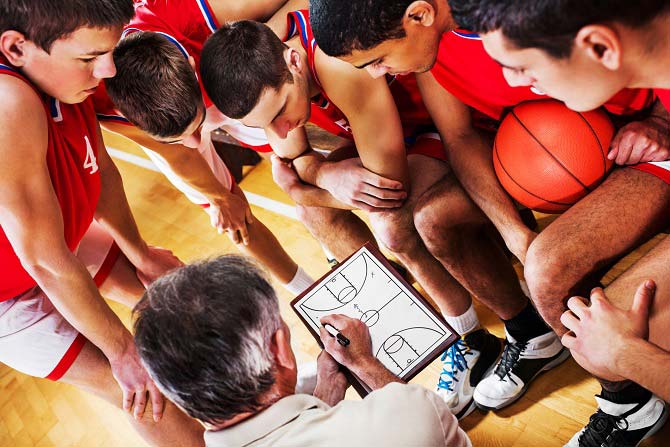
Fast break! Or do you prefer to rely on the defense? In basketball, the tactics of the game often decide between defeat and victory. Here you will learn everything about the basics of strategy, the typical tactics in basketball and which exercises you can use to practice the different moves.
What does tactics mean in basketball?
In basketball, tactics play an important role because they often decide whether a team wins or loses the game. But what exactly does tactics in basketball mean?
Tactics in basketball is understood as all organised measures to attack and defend, which are used by players to reach a premeditated conclusion. There are two types of tactics: defensive and offensive tactics.
In addition, a distinction can once again be made between pre-tactics and team tactics:
- Pre-tactics describes moves in offense and defense that are only played by certain players in a team.
- With the team tactics all five players will try to reach a certain goal at the same time together.
Through the targeted use of different tactics, the team can get decisive advantages in the basketball game, which can ultimately lead to winning the match.
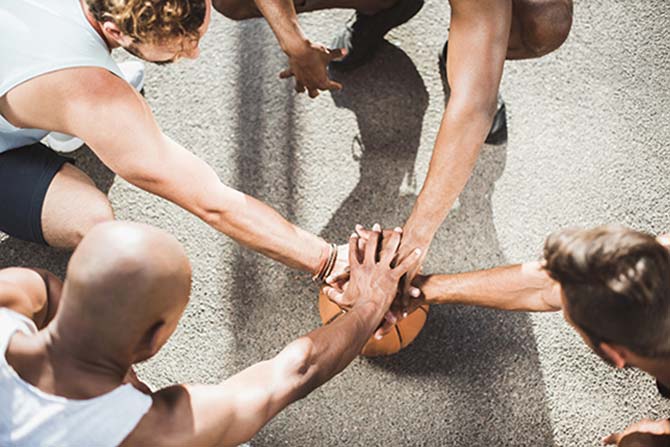
Basketball Tactics 101
In order to understand the finer points of tactics and strategy in basketball, you should know the basic terms in advance. We have everything you need to know about the playing field, the zone and the player positioning so that you can become a tactics expert.
The Court
Basketball is played on a rectangular playing field with a hard surface. The playing field itself is divided by circles, lines and zones, each of which has its own set of rules. In the following infographics we have marked the most important lines and areas on the basketball court for you.
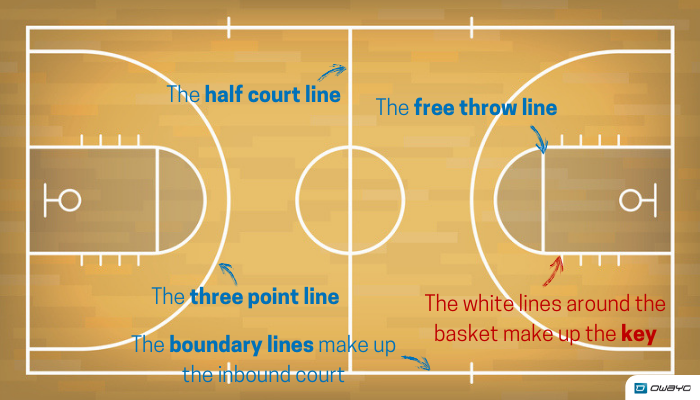
The Paint
Basically, the playing field is divided into different sections. The Paint is the area located in the white rectangle under the baskets and extends to the free-throw line. It plays an important role in attack and defense. Players on offense can only stay in the paint for 3 second before a foul is called.
The Positions
In order to understand the tactics involved in basketball, it's important to have a grasp on different positions. Important to know: In basketball, there are no fixed offensive or defensive positions, as is the case with football or handball. All five players on the playing field must be able to both attack and defend. Nevertheless, each player usually has a specific role. Players are usually divided into two groups Forwards and Guards.
In basketball there are always five players on the field. There are up to seven substitutes who can be switched as often as needed. The starting line-up in basketball is called the Starting Five. Today, the positions are usually the following: one center, two forwards (wing or attacking players) and two guards. This is also known as the 2-1-2 formation. However, other starting positions are also possible, like three guards.
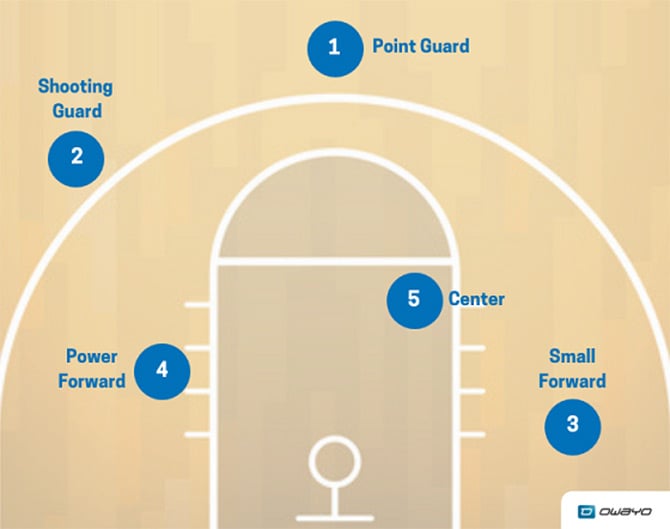
The Center
The Center is usually the biggest and physically strongest player on the court. He normally stands with his back to the basket and works in the paint, i.e. directly under the basket. His goal is to gather rebounds.
The Guard
The guards are usually the smallest yet fastest players on the court. They can be divided into "shooting guards" and "point guards". The shooting guard focuses on distance 3 pointers while the point guard brings the ball to half court and calls the plays. He needs both ball handling skills and a solid grasp of the game. The position is therefore also called "playmaker".
The Forward
Forwards can fall into two categories: The "small forward" and the "power forward". Both forwards are offensive players who, like the center, play in the paint and get rebounds. The biggest difference between the two positions is the size of the players.
The Power Forward is larger and plays with his back to the basket similar to the center. His goal is to snag rebounds on offense and defense. The Small Forward focuses primarily on working the ball to the paint. Good ball handling, speed and strong passing are prerequisites for a small forward.
All positions are numbered from the smallest to the largest player. The counting starts with the smallest player with number 1 (Point Guard) and goes up to the largest player with number 5 (Center).
In the following video the different game positions will be explained simply and clearly.
What are the basic basketball tactics?
In basketball, a distinction is made between attack and defense setups. However, a quick turnover can change this quickly: The defense serves a team to be able to attack quickly again. Because the general goal in basketball is to score more goals at the end and thus more points than the opponent. Here we present you the most well-known moves for offense and defense.
Defensive Plays in Basketball
In basketball, the goal of the defense is to gain possession of the ball by stealing the ball or getting a defensive rebound . Their task is to prevent the opponent from scoring. Basketball players do this by blocking and stealing the ball.
In basketball there are different defense strategies to choose from. The best known moves in defense are usually man-on-man defense and zone defence.
Man-on-Man Defense
In man-on-man defence or one-man defence - as the name suggests - each attacker is assigned an individual defender. The defender has the task making life for that player difficult.

Zone Defense
Zone defense is a defense in which players focus not on a single opponent but on an area or zone. Each player has the objective of controlling a certain area (e.g. the space below the basket). If an opposing player enters this area, the defender tries to stop and block him. If the opponent leaves the area, then it's the reponsibility of the other defending player to cover that opponent.
Hybrid Defenses
During the course of a game, teams usually change their defensive strategy often from man on man to zone defense to keep the opponents on their toes. Theoretically, teams can also use a mix of both styles of defense, but the teams rarely use them.
For example, a four-player basketball team can play zone defense, while a defensive player guards an opponent man on man, putting pressure on him, known as "box-and-one defense." This is useful when there is a dominant player on the opposing team.
Additional tips to practicing defence can be found in the following video of ILoveBasketballTV.
Offense in Basketball
On offense, there are many different tools available to your team. The goal of the attack is to break through the opponent's defense and set up an uncontested shot. For this you will need strong fundamentals: dribbling, passing and shooting.
Here we present the most important tactical plays and attacking moves in basketball. The attackers should choose their play based on what the opponent is doing. Find the flaws and exploit them.
Fast Break versus Playing for Position
Basically two basic tactics can be distinguished in basketball: The "fast break" and the play-centred game.
In a fast break the offense attempts to move the ball forward as quickly as possible so that the defense is out of position and outnumbered. The focus here is on speed and quick passes.
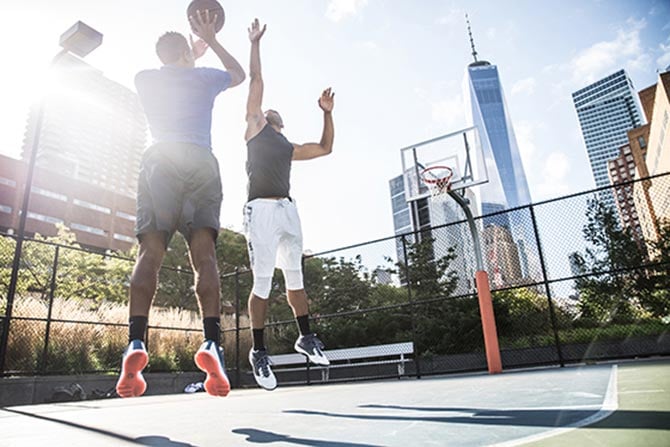
In positional play, however, the offense tries to adjust to the opponent's defense. A good line-up (positions) builds up the game. Good targeted movement, passing and blocking (in man-on-man defense) and cutting (in zone defense) dictate whether a ball possession will lead to scoring points.
In basketball, however, there are many more plays. These are also called systems. This refers to variants of well-rehearsed plays where every attacker has a certain path. However, they are quite complex and have to be rehearsed and practised well in advance. You can find examples of these moves below.
The Pick and Roll
The pick and roll is a popular move in basketball. It's often used in 2 on 2 scenarios.
With this move, the attacker without the ball blocks the path of the defender covering the leader. The attacker with the ball is then free to make an uncontested shot.
The remaining three attackers are responsible for blocking the other three defenders. Here's an example of how this looks on the court:
Triangle Offense
The Triangle Offense is also a popular attack strategy in basketball. A good team relationship is very important: The attackers form a triangle of three players.
This triangle is usually formed by the center, a forward and a guard. The players are positioned close to the basket, in a corner of the playing field next to the basket and on the wing.
This formation promotes fast passing and movement, making it very difficult for the opponent's defense to block the attackers. In the video you can see how it looks on the court.
Princeton Offense
A lesser known but very effective attack setup is the Princeton Offense. This tactic is characterised by high passing and quick mobility and an avoidance of the paint close to the basket.
In a classical attack set up in basketball, the center and power forward are usually near the basket. The small forward is usually around the free throw line and the two guards players are at the three-point line.
The Princeton offense is different: The center is usually located at the top of the key, while the remaining players are placed outside the three-point line. This forces the opposing team to defend far away from the basket, creating a lane in the zone for a lay-up. The goal of this system is to confuse the defense by constant passes and running. With this, the offense creates an opportunity to penetrate into this free space with a backdoor pass to make an unchallenged shot.
Want to see the Princeton offense in action? Here's a compilation from various NBA games:
Basketball: Knowledge & Accessories
That's our overview of the strategic defense and offensive set ups in basketball. If you want to expand your knowledge of basketball even further, read up on the most important Rules of Basketball. That way, you'll be prepared for the next game: whether you just want to throw a few baskets yourself or cheer on your favourite team!
You will also find many more articles about basketball in our magazine. If you'd like your own custom basketball kit, visit our 3D Kit Designer and create your own own basketball jersey!
We wish you the best!
Photo Credits: Main image: © gettyimages/skynesher, Image 1: © gettyimages/LightFieldStudios, Image 2: © gettyimages/Dimarik, Image 3: © gettyimages/Dimarik, Image 4: gettyimages/Geber86, Image 5: gettyimages/einchpunch.